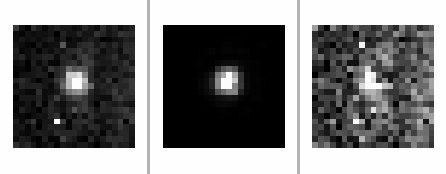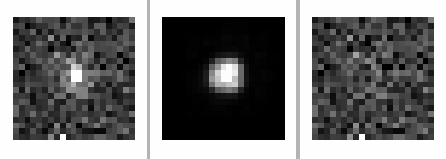As we saw, in theory, photometry by adjustment of PSF is most precise. However, this method rests on a very precise knowledge of the PSF.
We thus tested the estimate of the adjustment of PSF in the case of truths stars present in the fields of our supernovæ on Planetary Camera.
Figure 8.15 watch residuals of the adjustment of a PSF on a brilliant star and a weak star. We see that there remain significant residuals on the level of the heart of star for brilliant star. These residuals are up to 10 times larger than the awaited error. These residuals do not have clear geometrical structures indicating a bad estimate of position .
 |
 |
We thus tried to modify the model in order to better reproduce PSFs observed. For that we modified the core of convolution which is applied after the rééchantillonnage to the normal pixelisation of the PSF. This core of convolution makes it possible to take into account diffusions of load in the camera of a pixel considered towards these closer neighbors (about 5% for the adjacent pixels). The camera growing old, the quality of CCDs worsens and involves in theory an increase in the transfers. We thus tested cores with a more significant diffusion but without result, the residuals are generally of the same order of magnitude. Moreover, for cores with strong diffusion, we see appearing concentric oscillations indicating a too significant correction.
A last correction could be made. Correction of the inefficiency of transfer of load of each pixel before the adjustment. However, the effects for the of the same pixels line are negligible, it could have a measurable effect on the columns. This way was not studied front in this analysis.
TinyTim thus does not make it possible to produce models of sufficiently precise PSFs to reproduce the profiles observed for brilliant stars. The use of these PSFs introducing in practice an undervaluation of flux between 5 and 10%.
For weak stars, the residual is on the awaited basic sound level. The error on the model has in this moderate case only one influence. We moreover checked than the fluxes obtained by means of this photometry and those obtained by a aperture photometry were in agreement. We will thus use this estimate within the limit of weak fluxes.
As we saw, the differences in term of performance for great fluxes are almost equivalent for the aperture photometry. We will thus use this method to make the estimate of fluxes of the supernovæ with great flux, i.e. , supernovæ with the redshifts lower than 1 i.e. 2000fr, 2001go, 2001gq and 2001gy.
For average and weak fluxes, we will use the photometry of PSF when the errors of aperture are much larger than the errors on flux by adjustment of PSF. It will be the case in practice only for the points at the end of the lightcurve for Nos two supernovæ with shifts towards the red beyond 1: 2001gn and 2001hb.
Lastly, we will see that the estimate of the bottom coming from the galaxy host returns the use of an adjustment of PSF even more difficult.